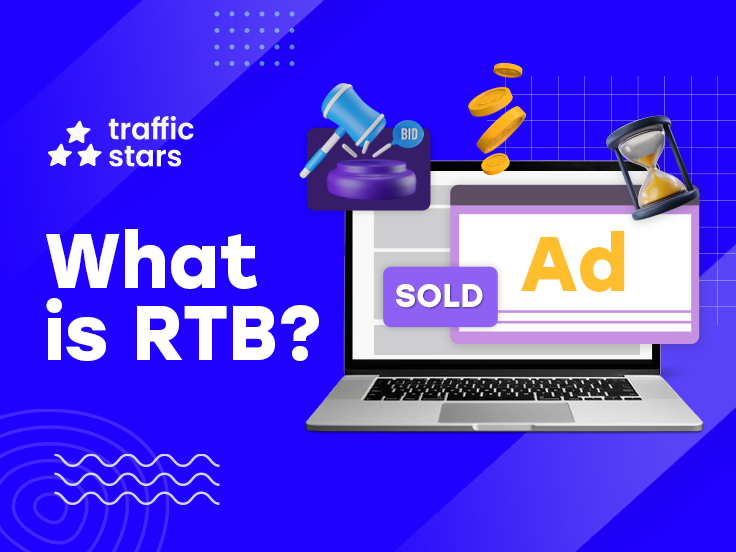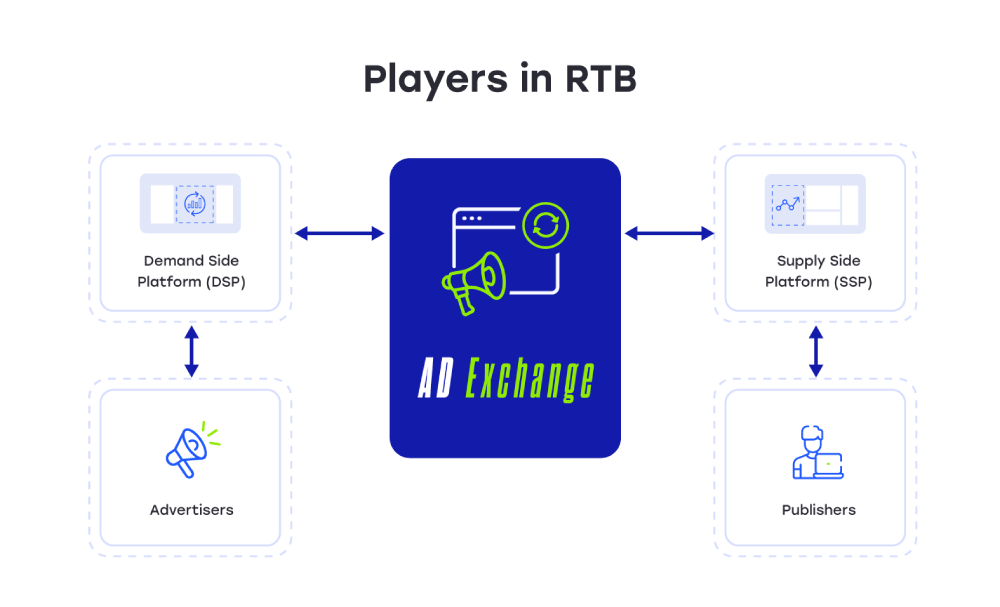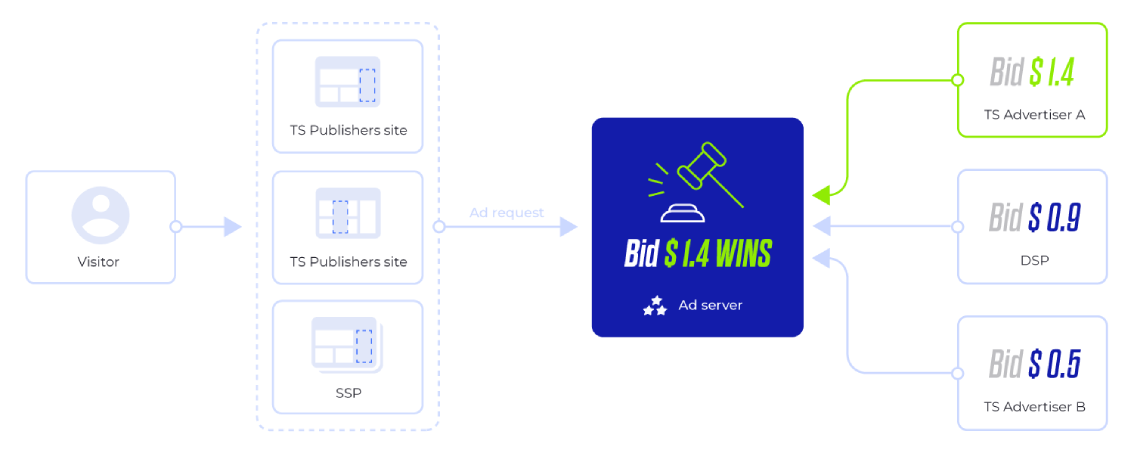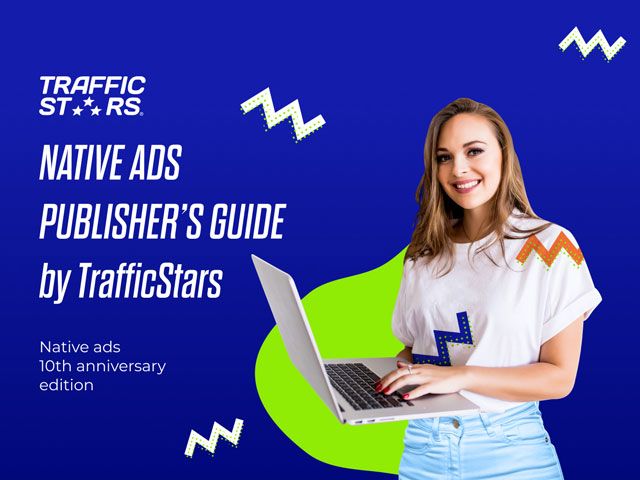
RTB (Real-Time Bidding) refers to the automated buying and selling of advertising space in real-time through specialized platforms and technologies.
RTB: Key Principles
- Advertising slots are auctioned off based on specific target criteria, with the highest bid per slot winning the auction.
- Instant bidding occurs as soon as the page or application loads, enabling advertisers to connect with their target audience precisely when they are most engaged.
- Advertisers have the flexibility to define various parameters for their target audience, such as geographic location, interests, behavior, and other relevant factors.

Content providers can optimize their advertising revenue, while advertisers can fine-tune their campaigns for maximum effectiveness.
The RTB Process
- A user visits a website or application.
- The system identifies available advertising space eligible for auction.
- An auction commences, with advertisers bidding to have their ads displayed.
- The highest bid secures the ad placement, which is then presented to the user.

TrafficStars RTB self-serve platform uses big data, intelligent algorithms, and state-of-the-art technology to let publishers maximize their revenues and help advertisers reach the most relevant users. This powerful solution helps both sides increase efficiency and achieve their goals.
⭐ Try out RTB together with Trafficstars and squeeze the most profits out of your ad campaigns!
RTB and Programmatic Advertising: Same Thing?
While closely intertwined, Real-Time Bidding (RTB) and programmatic advertising are distinct concepts within the digital advertising realm.
- RTB is a specialized method for purchasing and selling advertising space instantaneously through auctions, driven by specific audience targeting criteria. While RTB falls under the umbrella of programmatic advertising, it's just one aspect of the broader spectrum.
- Programmatic advertising encompasses various automated ad buying and delivery methods, such as RTB, Programmatic Direct, Private Marketplace Deals, and Automated Guaranteed. Within this framework, platforms and technologies are utilized to automate the procurement, placement, and optimization of advertising campaigns.
Differences and Similarities
RTB, as a component of programmatic advertising, facilitates the real-time buying and selling of ad space through auctions.
Programmatic advertising encompasses more than just RTB; it also includes various methods and technologies like Programmatic Direct, Private Marketplace Deals (PMP), and Automated Guaranteed (AG).
While RTB focuses on ad buying, programmatic advertising covers a broader spectrum of automated ad purchasing and optimization techniques.
Private Marketplace (PMP)
Private Marketplace (PMP) is a format within programmatic advertising that conducts private auctions, allowing select publishers and advertisers to transact directly, bypassing public auction markets.
PMP: Key Features
- Privacy: PMP ensures confidentiality and trading control, as only invited participants can join.
- Direct deals: Publishers and advertisers can directly negotiate agreements to display ads on websites under specific terms.
- Inventory quality: PMP typically provides premium inventory and higher-quality advertising space compared to open markets.
PMP: Advantages of Use
Inventory management: Advertisers have the freedom to select specific publishers and ad spaces for placing their ads.
Direct access to premium inventory: Accessing exclusive and high-quality inventory that might not be available in open markets.
Enhanced brand management: The capability to manage the advertising environment effectively, ensuring brand protection from inappropriate content.
PMP: Possible Use
Direct contracts: Advertisers and publishers can establish direct, long-term agreements, reducing costs and enhancing outcomes.
Exclusive access: Advertisers can secure exclusive access to particular publishers or target audiences on mutually agreeable terms.
RTB vs Programmatic Advertising
RTB stands as a cornerstone in programmatic advertising, enabling the dynamic buying and selling of ad space through real-time auctions.
Programmatic Advertising encompasses a spectrum of automated buying and placement methods, including RTB, PMP, Open Marketplace, and Automated Guaranteed.
RTB vs PMP
RTB operates on an open auction model, fostering real-time competition between sellers and buyers for ad space. On the other hand, PMP offers a more controlled environment through private auctions, where publishers and advertisers engage in direct deals with predefined terms and prices.
Preferences and Scenarios
RTB suits scenarios demanding flexibility and access to extensive inventory, coupled with precise targeting capabilities.
PMP caters to advertisers valuing inventory quality, privacy, and the ability to negotiate deals directly with specific publishers.
Software Safeguards
Programmatic Guaranteed ensures advertisers secure access to specific inventory at predetermined prices and volumes, based on prior agreements.
Programmatic Non-Guaranteed facilitates participation in ad space auctions with real-time dynamic pricing mechanisms.
Common Use Cases
RTB is widely employed for efficiently acquiring inventory from the open market, leveraging auction-based pricing to optimize advertising strategies.
PMP is utilized for negotiating direct deals with chosen publishers, particularly emphasizing inventory quality and trade confidentiality.
Ultimately, the choice between RTB, PMP, and other programmatic advertising formats hinges on campaign objectives, inventory availability, desired level of control and transparency, and advertiser preferences.
Exploring Different RTB Options
Within the realm of RTB, various auction mechanisms shape the pricing dynamics for displaying ads. Let's delve into three primary options for RTB auctions: header bidding, first-price auctions, and second-price auctions:
Header Bidding
- Principle: Publishers extend advertising space to multiple partners before soliciting ads through the main Supply-Side Platform (SSP), enabling advertisers to bid prior to the official auction.
- Advantages: Enhances inventory value for publishers, provides heightened transparency and control over bidding processes.
- Usage: An effective strategy for publishers aiming to monetize ad space and enhance inventory quality.
First Price Auction
- Principle: The advertiser offering the highest bid for advertising space pays precisely that amount (primary bid).
- Advantages: Offers simplicity and clarity in pricing, ensuring advertisers know the exact cost per impression.
- Usage: Predominantly employed in RTB auctions to determine ad space pricing.
Second Price Auction
- Principle: The highest bidder pays the price proposed by the next highest bidder, augmented by the minimum step price.
- Advantages: Promotes accurate bidding by advertisers, thereby minimizing underpricing.
- Usage: Commonly employed in RTB auctions to ensure equitable pricing and foster healthy competition.
Choosing an Auction Model
- Header bidding: Utilized to enhance inventory values and enhance trading transparency.
- First price auctions: Streamlined method for determining per-listing prices.
- Second price auctions: Encourage fair participation in auctions by maintaining reasonable pricing.
Ad Exchanges and Ad Networks
Ad exchanges serve as digital platforms facilitating automated trading of advertising spaces between advertisers and publishers. These exchanges host real-time auctions (RTB), allowing advertisers to bid for ad space to reach their target audiences. Key advantages include heightened efficiency in purchasing ad inventory, high levels of transparency, flexible targeting options, and optimized pricing per view.
Ad networks are platforms that aggregate inventory from various publishers, offering it to advertisers through a unified program. They provide access to publishers' inventory through pre-negotiated advertising contracts and deals, often without direct interaction between advertisers and publishers. While ad networks enable broader audience reach and streamline campaign management, they may sacrifice some flexibility and transparency compared to ad exchanges.
Distinguishing Ad Exchanges from Ad Networks
Ad exchanges facilitate real-time RTB auctions, whereas ad networks rely on negotiated advertising deals.
Ad exchanges typically offer higher transparency levels compared to ad networks.
Ad Exchanges afford more flexibility in pricing, targeting, and control compared to ad networks.
Selection and Use Cases
Ad exchanges: Perfect for advertisers and publishers seeking maximum transparency and flexibility in the buying and selling of advertising inventory.
Ad networks: Ideal for rapidly expanding audience reach, simplifying ad purchases, and minimizing effort.
Advantages of RTB for Publishers
Maximized income:
- Publishers can secure better prices for their ad space through competitive real-time auctions.
- Optimizing inventory filling to enhance effective monetization.
Transparency and control:
- Offers complete transparency in trading, allowing publishers to see bidding activity and control the types of ads displayed on their platforms.
- Enables content management and impression control to maintain brand consistency.
Enhanced performance:
- Enables precise targeting to reach specific audiences.
- Facilitates dynamic campaign optimization and highlights the most profitable traffic sources.
Premium inventory monetization:
- Optimizes premium ad slots to achieve high cost-per-impression rates.
- Provides opportunities for participation in private markets (PMP) to expand premium inventory monetization.
Diversified monetization options:
- Utilizes various ad formats to boost revenue.
- Integrates with different suppliers to maximize monetization efficiency.
Process automation:
- Speeds up decision-making processes and optimizes publisher activities.
- Reduces time spent on operational tasks and improves resource utilization.
Advantages of RTB for Advertisers
Precise targeting: Advertisers can effectively target specific audiences and deliver ads to the most relevant users.
Cost efficiency: RTB enables budget optimization by adjusting the cost per impression and selecting the most efficient advertising platforms.
Transparency and control: Advertisers gain visibility into auction outcomes, ensuring transparency in trading and control over ad placements.
Access to extensive options: RTB offers access to a vast array of inventory and advertising platforms.
Dynamic optimization: Real-time campaign optimization enhances performance by responding swiftly to changing conditions.
Flexible campaign setup: Advertisers can promptly adapt to shifts and experiment with various strategies in real time.
Become an Advertiser
You’ll receive:
- Intuitive campaign setup customized to your requirements.
- The best targeting tools.
- Continuous performance analysis for optimization purposes.
- Extensive coverage reaching millions of customers.
Successful conversions are just one click away!




